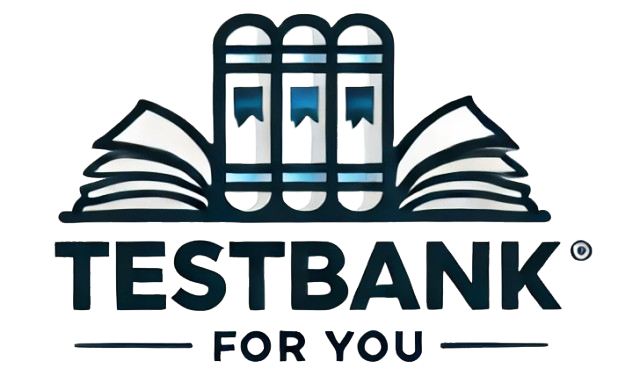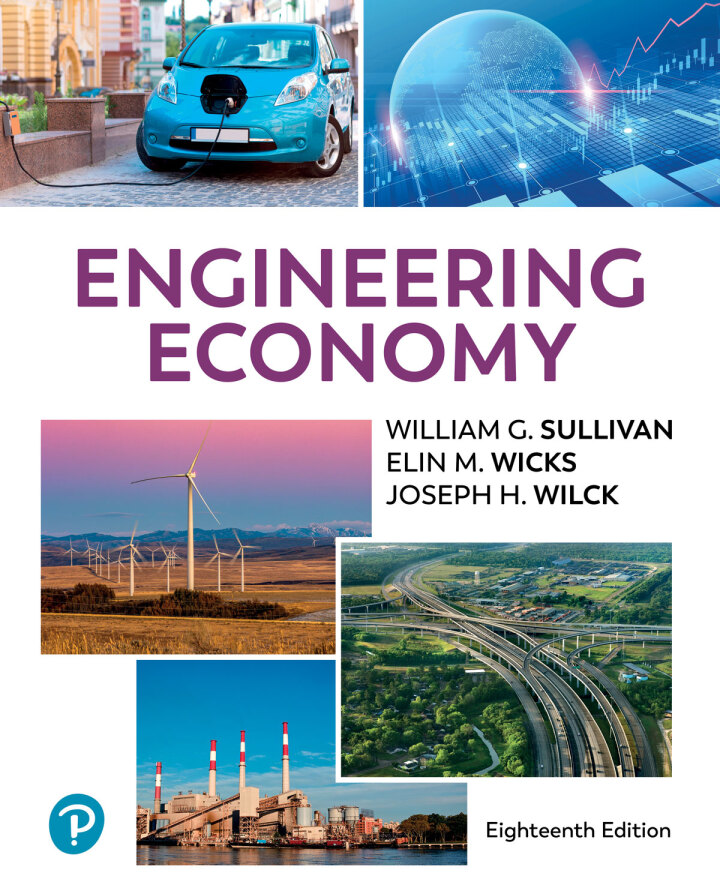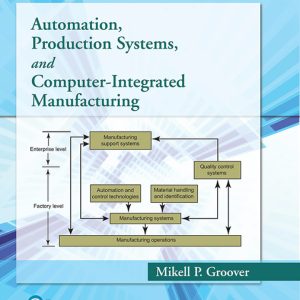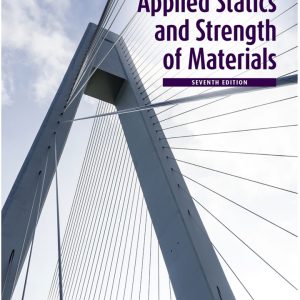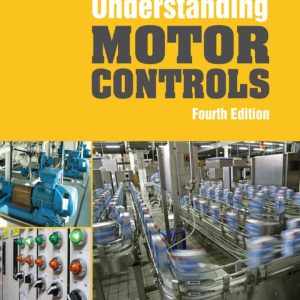Engineering Economy 18th Edition Sullivan Solution Manual
Original price was: $60.00.$30.00Current price is: $30.00.
Solution Manual for Engineering Economy, 18th Edition, William G. Sullivan, Elin M Wicks, Joseph H. Wilck, ISBN-13: 9780138096823 To get more information about this please send us E-mail to smtb7000@gmail.com
Description
Engineering Economy 18th Edition Sullivan Solution Manual
Solution Manual for Engineering Economy, 18th Edition, William G. Sullivan, Elin M Wicks, Joseph H. Wilck, ISBN-13: 9780138096823
Table of Contents
1. Introduction to Engineering Economy
1.1 Introduction
1.2 The Principles of Engineering Economy
1.3 Engineering Economy and the Design Process
1.4 Using Spreadsheets in Engineering Economy
1.5 Try Your Skills
1.6 Summary
2. Cost Concepts and Design Economics
2.1 Cost Terminology
2.2 The General Economic Environment
2.3 Cost-Driven Design Optimization
2.4 Present Economy Studies
2.5 Case Study: The Economics of Daytime Running Lights
2.6 Value Engineering
2.7 In-Class Exercise
2.8 Try Your Skills
2.9 Summary
3. Cost-Estimation Techniques
3.1 Introduction
3.2 An Integrated Approach
3.3 Selected Estimating Techniques (Models)
3.4 Parametric Cost Estimating
3.5 Case Study: Electric Vehicle Battery Recovery
3.6 Electronic Spreadsheet Modeling: Learning Curve
3.7 In-Class Exercise
3.8 Try Your Skills
3.9 Summary
4. The Time Value of Money
4.1 Introduction
4.2 Simple Interest
4.3 Compound Interest
4.4 The Concept of Equivalence
4.5 Notation and Cash-Flow Diagrams and Tables
4.6 Relating Present and Future Equivalent Values of Single Cash Flows
4.7 Relating a Uniform Series (Annuity) to Its Present and Future Equivalent Values
4.8 Summary of Interest Formulas and Relationships for Discrete Compounding
4.9 Deferred Annuities (Uniform Series)
4.10 Equivalence Calculations Involving Multiple Interest Formulas
4.11 Uniform (Arithmetic) Gradient of Cash Flows
4.12 Geometric Sequences of Cash Flows
4.13 Interest Rates that Vary with Time
4.14 Nominal and Effective Interest Rates
4.15 Compounding More Often than Once per Year
4.16 Interest Formulas for Continuous Compounding and Discrete Cash Flows
4.17 Case Study: Understanding Economic Equivalence
4.18 In-Class Exercise
4.19 Try Your Skills
4.20 Summary
5. Evaluating a Single Project
5.1 Introduction
5.2 Determining the Minimum Attractive Rate of Return (MARR)
5.3 The Present Worth Method
5.4 The Future Worth Method
5.5 The Annual Worth Method
5.6 The Internal Rate of Return Method
5.7 The External Rate of Return Method
5.8 The Payback (Payout) Period Method
5.9 Case Study: Data Center Establishment Project
5.10 Electronic Spreadsheet Modeling: Payback Period Method
5.11 In-Class Exercise
5.12 Try Your Skills
5.13 Summary
Appendix 5-A The Multiple Rate of Return Problem with the IRR Method
6. Comparison and Selection among Alternatives
6.1 Introduction
6.2 Basic Concepts for Comparing Alternatives
6.3 The Study (Analysis) Period
6.4 Useful Lives Are Equal to the Study Period
6.5 Useful Lives Are Unequal among the Alternatives
6.6 Personal Finances
6.7 Case Study: Ned and Larry’s Ice Cream Company
6.8 Postevaluation of Results
6.9 Project Postevaluation Spreadsheet Approach
6.10 In-Class Exercise
6.11 Try Your Skills
6.12 Summary
7. Depreciation and Income Taxes
7.1 Introduction
7.2 Depreciation Concepts and Terminology
7.3 The Classical (Historical) Depreciation Methods
7.4 The Modified Accelerated Cost Recovery System
7.5 A Comprehensive Depreciation Example
7.6 Introduction to Income Taxes
7.7 The Effective Corporate Income Tax Rate
7.8 Gain (Loss) on the Disposal of an Asset
7.9 General Procedure for Making After-Tax Economic Analyses
7.10 Illustration of Computations of ATCFs
7.11 Economic Value Added
7.12 In-Class Exercise
7.13 Try Your Skills
7.14 Summary
8. Price Changes and Exchange Rates
8.1 Introduction
8.2 Terminology and Basic Concepts
8.3 Fixed and Responsive Annuities
8.4 Differential Price Changes
8.5 Spreadsheet Application
8.6 Global Exchange Rates and Purchasing Power Concepts
8.7 Case Study: Selecting Electric Motors to Power an Assembly Line
8.8 In-Class Exercise
8.9 Try Your Skills
8.10 Summary
9. Replacement Analysis
9.1 Introduction
9.2 Reasons for Replacement Analysis
9.3 Factors that Must Be Considered in Replacement Studies
9.4 Typical Replacement Problems
9.5 Determining the Economic Life of a New Asset (Challenger)
9.6 Determining the Economic Life of a Defender
9.7 Comparisons in Which the Defender’s Useful Life Differs from that of the Challenger
9.8 Retirement without Replacement (Abandonment)
9.9 After-Tax Replacement Studies
9.10 Case Study: Replacement of a Hospital’s Emergency Electrical Supply System
9.11 In-Class Exercise
9.12 Try Your Skills
9.13 Summary
10. Evaluating Projects with the Benefit-Cost Ratio Method
10.1 Introduction
10.2 Perspective and Terminology for Analyzing Public Projects
10.3 Self-Liquidating Projects
10.4 Multiple-Purpose Projects
10.5 Difficulties in Evaluating Public-Sector Projects
10.6 What Interest Rate Should Be Used for Public Projects?
10.7 The Benefit-Cost Ratio Method
10.8 Evaluating Independent Projects by B-C Ratios
10.9 Comparison of Mutually Exclusive Projects by B-C Ratios
10.10 Case Study: Rural Broadband Internet Expansion
10.11 Try Your Skills
10.12 Summary
11. Breakeven and Sensitivity Analysis
11.1 Introduction
11.2 Breakeven Analysis
11.3 Sensitivity Analysis
11.4 Multiple Factor Sensitivity Analysis
11.5 CASE STUDY: If You Build It, They Will Come
11.6 Try Your Skills
11.7 Summary
12. Probabilistic Risk Analysis
12.1 Introduction
12.2 Sources of Uncertainty
12.3 The Distribution of Random Variables
12.4 Evaluation of Projects with Discrete Random Variables
12.5 Evaluation of Projects with Continuous Random Variables
12.6 Evaluation of Risk and Uncertainty by Monte Carlo Simulation
12.7 Performing Monte Carlo Simulation with a Computer
12.8 Decision Trees
12.9 Real Options Analysis
12.10 CASE STUDY: Retirement Balance
12.11 Summary
13. The Capital Budgeting Process
13.1 Introduction
13.2 Debt Capital
13.3 Equity Capital
13.4 The Weighted Average Cost of Capital (WACC)
13.5 Project Selection
13.6 Postmortem Review
13.7 Budgeting of Capital Investments and Management Perspective
13.8 Leasing Decisions
13.9 Capital Allocation
13.10 Summary
14. Decision Making Considering Multiattributes
14.1 Introduction
14.2 Examples of Multiattribute Decisions
14.3 Choice of Attributes
14.4 Selection of a Measurement Scale
14.5 Dimensionality of the Problem
14.6 Noncompensatory Models
14.7 Compensatory Models
14.8 Summary
